Detecting People on the Street and the Streetscape Physical Environment from Baidu Street View Images and Their Effects on Community-Level Street Crime in a Chinese City
Abstract
:1. Introduction
2. Literature Review
2.1. Street Crime and People on the Street
2.2. Street Crime and Streetscape Physical Environment
2.3. Data Sources and Methods Used in Related Research
3. Study Area, Data, and Method
3.1. Study Area
3.2. Data
3.2.1. Crime Data
3.2.2. Collect BSV Images and Extract Streetscape Features
- Fetch BSVs from the Baidu Map Website
- Object Detection Using the Faster R-CNN Network
- Semantic Segmentation Using the PSPNet Network
3.2.3. Control Variables
- Socioeconomic and Demographic Factors
- Land Use Features
- Formal Surveillance
- Transportation Facilities
3.3. Method
4. Results
5. Discussion
6. Conclusions
Author Contributions
Funding
Data Availability Statement
Acknowledgments
Conflicts of Interest
References
- Cohen, L.; Felson, M. Social change and crime rate trends: A routine activity approach. Am. Sociol. Rev. 1979, 44, 588–608. [Google Scholar] [CrossRef]
- Brantingham, P.L.; Brantingham, P.J. A theoretical model of crime hot spot generation. Stud. Crime Crime Prev. 1999, 8, 7–26. [Google Scholar]
- Weisburd, D. From criminals to criminal contexts: Reorienting criminal justice research and policy. Adv. Criminol. Theory 2002, 10, 197–216. [Google Scholar]
- Cozens, P.; Davies, T. Crime and residential security shutters in an Australian suburb: Exploring perceptions of ‘eyes on the street’, social interaction and personal safety. Crime Prev. Community Saf. 2013, 15, 175–191. [Google Scholar] [CrossRef] [Green Version]
- He, L.; Páez, A.; Liu, D. Built environment and violent crime: An environmental audit approach using Google Street View. Comput. Environ. Urban Syst. 2017, 66, 83–95. [Google Scholar] [CrossRef]
- Rundle, A.G.; Bader, M.D.M.; Richards, C.A.; Neckerman, K.M.; Teitler, J.O. Using google street view to audit neighborhood environments. Am. J. Prev. Med. 2011, 40, 94–100. [Google Scholar] [CrossRef] [Green Version]
- Wolfe, M.K.; Mennis, J. Does vegetation encourage or suppress urban crime? Evidence from Philadelphia, PA. Landsc. Urban Plan. 2012, 108, 112–122. [Google Scholar] [CrossRef]
- Zhou, H.; Liu, L.; Lan, M.; Yang, B.; Wang, Z. Assessing the Impact of Nightlight Gradients on Street Robbery and Burglary in Cincinnati of Ohio State, USA. Remote Sens. 2019, 11, 1958. [Google Scholar] [CrossRef] [Green Version]
- Patino, J.E.; Duque, J.C.; Pardo-Pascual, J.E.; Ruiz, L.A. Using remote sensing to assess the relationship between crime and the urban layout. Appl. Geogr. 2014, 55, 48–60. [Google Scholar] [CrossRef]
- Hipp, J.R.; Lee, S.; Ki, D.; Kim, J.H. Measuring the Built Environment with Google Street View and Machine Learning: Consequences for Crime on Street Segments. J. Quant. Criminol. 2021, 1–29. [Google Scholar] [CrossRef]
- Amiruzzaman, M.; Curtis, A.; Zhao, Y.; Jamonnak, S.; Ye, X. Classifying crime places by neighborhood visual appearance and police geonarratives: A machine learning approach. J. Comput. Soc. Sci. 2021, 4, 813–837. [Google Scholar] [CrossRef] [PubMed]
- Khorshidi, S.; Carter, J.; Mohler, G.; Tita, G. Explaining Crime Diversity with Google Street View. J. Quant. Criminol. 2021, 37, 361–391. [Google Scholar] [CrossRef]
- Zhou, H.; Liu, L.; Lan, M.; Zhu, W.; Song, G.; Jing, F.; Zhong, Y.; Su, Z.; Gu, X. Using Google Street View imagery to capture micro built environment characteristics in drug places, compared with street robbery. Comput. Environ. Urban Syst. 2021, 88, 101631. [Google Scholar] [CrossRef]
- Zhang, F.; Fan, Z.; Kang, Y.; Hu, Y.; Ratti, C. “Perception bias”: Deciphering a mismatch between urban crime and perception of safety. Landsc. Urban Plan. 2021, 207, 104003. [Google Scholar] [CrossRef]
- Yue, H.; Zhu, X. The influence of urban built environment on residential burglary in China: Testing the encounter and enclosure hypotheses. Criminol. Crim. Justice 2019, 21, 508–528. [Google Scholar] [CrossRef]
- Clarke, R.V.; Felson, M. Routine Activity and Rational Choice; Transaction: New Brunswick, NJ, USA, 1993. [Google Scholar]
- Roncek, D.W.; Bell, R. Bars, blocks, and crimes. J. Environ. Syst. 1981, 11, 35–47. [Google Scholar] [CrossRef]
- McCord, E.S.; Ratcliffe, J.H. Intensity value analysis and the criminogenic effects of land use features on local crime patterns. Crime Patterns Anal. 2009, 2, 17–30. [Google Scholar]
- Groff, E.; Mccord, E.S. The role of neighborhood parks as crime generators. Secur. J. 2012, 25, 1–24. [Google Scholar] [CrossRef]
- Kubrin, C.E.; Squires, G.D.; Graves, S.M.; Ousey, G.C. Does fringe banking exacerbate neighborhood crime rates? Criminol. Public Policy 2011, 10, 437–466. [Google Scholar] [CrossRef]
- Jung, Y.; Chun, Y.; Kim, K. Modeling Crime Density with Population Dynamics in Space and Time: An Application of Assault in Gangnam, South Korea. Crime Delinq. 2020, 68, 253–283. [Google Scholar] [CrossRef]
- Caminha, C.; Furtado, V.; Pequeno, T.H.C.; Ponte, C.; Melo, H.P.M.; Oliveira, E.A.; Andrade, J.S. Human mobility in large cities as a proxy for crime. PLoS ONE 2017, 12, e0171609. [Google Scholar] [CrossRef] [PubMed] [Green Version]
- Boivin, R. Routine activity, population(s) and crime: Spatial heterogeneity and conflicting Propositions about the neighborhood crime-population link. Appl. Geogr. 2018, 95, 79–87. [Google Scholar] [CrossRef]
- Vomfell, L.; Härdle, W.K.; Lessmann, S. Improving crime count forecasts using Twitter and taxi data. Decis. Support Syst. 2018, 113, 73–85. [Google Scholar] [CrossRef]
- Felson, M.; Eckert, M. Crime and Everyday Life, 5th ed.; Sage: Thousand Oaks, CA, USA, 2015. [Google Scholar]
- Song, G.; Liu, L.; Bernasco, W.; Xiao, L.; Zhou, S.; Liao, W. Testing indicators of risk populations for theft from the person across space and time: The significance of mobility and outdoor activity. Ann. Am. Assoc. Geogr. 2018, 108, 1370–1388. [Google Scholar] [CrossRef]
- Wilcox, P.; Land, K.C.; Hunt, S.A. Criminal Circumstance: A Dynamic, Multi-Contextual Criminal Opportunity Theory; Aldine de Gruyter: New York, NY, USA, 2003. [Google Scholar]
- Brantingham, P.L.; Brantingham, P.J. Crime Pattern Theory. In Environmental Criminology and Crime Analysis; Wortley, R., Mazerolle, L., Eds.; Willan Publishing: Portland, OR, USA, 2008. [Google Scholar]
- Nee, C.; Taylor, M. Examining burglars’ target selection: Interview, experiment or ethnomethodology? Psychol. Crime Law 2000, 6, 45–59. [Google Scholar] [CrossRef]
- Mayhew, P. Defensible space: The current status of a crime prevention theory. Howard J. Crim. Justice 1979, 18, 150–159. [Google Scholar] [CrossRef]
- Yue, H.; Zhu, X.; Ye, X.; Guo, W. The Local Colocation Patterns of Crime and Land-Use Features in Wuhan, China. ISPRS Int. J. Geo-Inf. 2017, 6, 307. [Google Scholar] [CrossRef] [Green Version]
- Jones, H.R. Crime and the Urban Environment; Avebury: Brookfield, VT, USA, 1993. [Google Scholar]
- Shu, C.-F. Housing layout and crime vulnerability. Urban Des. Int. 2000, 5, 177–188. [Google Scholar]
- Yue, H.; Zhu, X.; Ye, X.; Hu, T.; Kudva, S. Modelling the effects of street permeability on burglary in Wuhan, China. Appl. Geogr. 2018, 98, 177–183. [Google Scholar] [CrossRef]
- Hillier, B. Can streets be made safe? Urban Des. Int. 2004, 9, 31–45. [Google Scholar] [CrossRef]
- Skogan, W.G.; Maxfield, M.G. Coping with Crime: Individual and Neighborhood Reactions; Sage Publications: Beverley Hills, CA, USA, 1981. [Google Scholar]
- Walker, B.B.; Schuurman, N. The pen or the sword: A situated spatial analysis of graffiti and violent injury in Vancouver, British Columbia. Prof. Geogr. 2015, 67, 608–619. [Google Scholar] [CrossRef]
- Spelman, W. Abandoned buildings: Magnets for crime? J. Crim. Justice 1993, 21, 481–495. [Google Scholar] [CrossRef]
- Russo, S.; Roccato, M.; Vieno, A. Criminal victimization and crime risk perception: A multilevel longitudinal study. Soc. Indic. Res. 2013, 112, 535–548. [Google Scholar] [CrossRef]
- Andresen, M.A.; Jenion, G.W. Ambient populations and the calculation of crime rates and risk. Secur. J. 2008, 23, 114–133. [Google Scholar] [CrossRef]
- Panigutti, C.; Tizzoni, M.; Bajardi, P.; Smoreda, Z.; Colizza, V. Assessing the use of mobile phone data to describe recurrent mobility patterns in spatial epidemic models. R. Soc. Open Sci. 2017, 4, 160950. [Google Scholar] [CrossRef] [Green Version]
- Mburu, L.W.; Helbich, M. Crime Risk Estimation with a Commuter-Harmonized Ambient Population. Ann. Am. Assoc. Geogr. 2016, 106, 804–818. [Google Scholar] [CrossRef]
- Hipp, J.R.; Bates, C.; Lichman, M.; Smyth, P. Using Social Media to Measure Temporal Ambient Population: Does it Help Explain Local Crime Rates? Justice Q. 2018, 36, 718–748. [Google Scholar] [CrossRef] [Green Version]
- Tucker, R.; O’Brien, D.T.; Ciomek, A.; Castro, E.; Wang, Q.; Phillips, N.E. Who ‘Tweets’ Where and When, and How Does it Help Understand Crime Rates at Places? Measuring the Presence of Tourists and Commuters in Ambient Populations. J. Quant. Criminol. 2021, 37, 333–359. [Google Scholar] [CrossRef]
- Johnson, P.; Andresen, M.A.; Malleson, N. Cell Towers and the Ambient Population: A Spatial Analysis of Disaggregated Property Crime. Eur. J. Crim. Policy Res. 2020, 27, 313–333. [Google Scholar] [CrossRef]
- Hanaoka, K. New insights on relationships between street crimes and ambient population: Use of hourly population data estimated from mobile phone users’ locations. Environ. Plan. B Urban Anal. City Sci. 2016, 45, 295–311. [Google Scholar] [CrossRef]
- Malleson, N.; Andresen, M.A. The impact of using social media data in crime rate calculations: Shifting hot spots and changing spatial patterns. Cartogr. Geogr. Inf. Sci. 2014, 42, 112–121. [Google Scholar] [CrossRef]
- Algahtany, M.; Kumar, L. A Method for Exploring the Link between Urban Area Expansion over Time and the Opportunity for Crime in Saudi Arabia. Remote Sens. 2016, 8, 863. [Google Scholar] [CrossRef]
- Zhang, F.; Zhang, D.; Liu, Y.; Lin, H. Representing place locales using scene elements. Comput. Environ. Urban Syst. 2018, 71, 153–164. [Google Scholar] [CrossRef]
- Naik, N.; Philipoom, J.; Raskar, R.; Hidalgo, C. Streetscore—Predicting the perceived safety of one million streetscapes. In Proceedings of the IEEE Conference on Computer Vision and Pattern Recognition Workshops, Columbus, OH, USA, 23–28 June 2014. [Google Scholar]
- Jiang, Y.; Chen, L.; Grekousis, G.; Xiao, Y.; Ye, Y.; Lu, Y. Spatial disparity of individual and collective walking behaviors: A new theoretical framework. Transp. Res. Part D Transp. Environ. 2021, 101, 103096. [Google Scholar] [CrossRef]
- Chen, L.; Lu, Y.; Sheng, Q.; Ye, Y.; Wang, R.; Liu, Y. Estimating pedestrian volume using Street View images: A large-scale validation test. Comput. Environ. Urban Syst. 2020, 81, 101481. [Google Scholar] [CrossRef]
- Yin, L.; Cheng, Q.; Wang, Z.; Shao, Z. ‘Big data’ for pedestrian volume: Exploring the use of Google Street View images for pedestrian counts. Appl. Geogr. 2015, 63, 337–345. [Google Scholar] [CrossRef]
- Sytsma, V.A.; Connealy, N.; Piza, E.L. Environmental Predictors of a Drug Offender Crime Script: A Systematic Social Observation of Google Street View Images and CCTV Footage. Crime Delinq. 2020, 67, 27–57. [Google Scholar] [CrossRef]
- Ren, S.; He, K.; Girshick, R.; Sun, J. Faster r-cnn: Towards real-time object detection with region proposal networks. Adv. Neural Inf. Processing Syst. 2015, 28, 91–99. [Google Scholar] [CrossRef] [Green Version]
- Zhao, H.; Shi, J.; Qi, X.; Wang, X.; Jia, J. Pyramid scene parsing network. In Proceedings of the IEEE Conference on Computer Vision and Pattern Recognition (CVPR), Honolulu, HI, USA, 21–26 July 2017; pp. 2881–2890. [Google Scholar]
- Li, X.; Zhang, C.; Li, W.; Ricard, R.; Meng, Q.; Zhang, W. Assessing street-level urban greenery using Google Street View and a modified green view index. Urban For. Urban Green. 2015, 14, 675–685. [Google Scholar] [CrossRef]
- Wu, L.; Liu, X.; Ye, X.; Leipnik, M.; Lee, J.; Zhu, X. Permeability, space syntax, and the patterning of residential burglaries in urban China. Appl. Geogr. 2015, 60, 261–265. [Google Scholar] [CrossRef]
- Du, F.; Liu, L.; Jiang, C.; Long, D.; Lan, M. Discerning the Effects of Rural to Urban Migrants on Burglaries in ZG City with Structural Equation Modeling. Sustainability 2019, 11, 561. [Google Scholar] [CrossRef] [Green Version]
- He, Q.; Li, J. The roles of built environment and social disadvantage on the geography of property crime. Cities 2022, 121, 103471. [Google Scholar] [CrossRef]
- Kurtz, E.M.; Koons, B.A.; Taylor, R.B. Land use, physical deterioration, resident-based control, and calls for service on urban streetblocks. Justice Q. 2006, 15, 121–149. [Google Scholar] [CrossRef]
- Kim, Y.-A.; Hipp, J.R. Density, diversity, and design: Three measures of the built environment and the spatial patterns of crime in street segments. J. Crim. Justice 2021, 77, 101864. [Google Scholar] [CrossRef]
- Chen, J.G.; Liu, L.; Xiao, L.Z.; Xu, C.; Long, D.P. Integrative Analysis of Spatial Heterogeneity and Overdispersion of Crime with a Geographically Weighted Negative Binomial Model. ISPRS Int. J. Geo-Inf. 2020, 9, 60. [Google Scholar] [CrossRef] [Green Version]
- Bernasco, W.; Block, R. Robberies in Chicago: A block-level analysis of the influence of crime generators, crime attractors, and offender anchor points. J. Res. Crime Delinq. 2011, 48, 33–57. [Google Scholar] [CrossRef]
- Fotheringham, A.S.; Yue, H.; Li, Z. Examining the influences of air quality in China’s cities using multi—Scale geographically weighted regression. Trans. GIS 2019, 23, 1444–1464. [Google Scholar] [CrossRef]
- Cornish, D.B.; Clarke, R.V. Understanding crime displacement: An application of rational choice theory. Criminology 1987, 25, 933–947. [Google Scholar] [CrossRef]
- Bogar, S.; Beyer, K.M. Green Space, Violence, and Crime: A Systematic Review. Trauma Violence Abus. 2016, 17, 160–171. [Google Scholar] [CrossRef]
- Blair, L. Community Gardens and Crime: Exploring the Roles of Criminal Opportunity and Informal Social Control; University of Cincinnati: Cincinnati, OH, USA, 2014. [Google Scholar]
- Kuo, F.E.; Sullivan, W.C. Environment and Crime in the Inner City. Environ. Behav. 2016, 33, 343–367. [Google Scholar] [CrossRef] [Green Version]
- Lin, B.B.; Egerer, M.H.; Ossola, A. Urban Gardens as a Space to Engender Biophilia: Evidence and Ways Forward. Front. Built Environ. 2018, 4, 4. [Google Scholar] [CrossRef] [Green Version]
- Roe, J.J.; Thompson, C.W.; Aspinall, P.A.; Brewer, M.J.; Duff, E.I.; Miller, D.; Mitchell, R.; Clow, A. Green space and stress: Evidence from cortisol measures in deprived urban communities. Int. J. Environ. Res. Public Health 2013, 10, 4086–4103. [Google Scholar] [CrossRef] [PubMed] [Green Version]
- Garvin, E.C.; Cannuscio, C.C.; Branas, C.C. Greening vacant lots to reduce violent crime: A randomised controlled trial. Inj. Prev. 2013, 19, 198–203. [Google Scholar] [CrossRef] [PubMed]
- Talen, E. Charter of the New Urbanism; McGraw Hill Education: New York, NY, USA, 2013. [Google Scholar]
- Jacobs, J. The Death and Life of Great American Cities; Random House: New York, NY, USA, 1961. [Google Scholar]
- Chalfin, A.; Hansen, B.; Lerner, J.; Parker, L. Reducing Crime Through Environmental Design: Evidence from a Randomized Experiment of Street Lighting in New York City. J. Quant. Criminol. 2021, 1–31. [Google Scholar] [CrossRef]
- Barnum, J.D.; Caplan, J.M.; Kennedy, L.W.; Piza, E.L. The crime kaleidoscope: A cross-jurisdictional analysis of place features and crime in three urban environments. Appl. Geogr. 2017, 79, 203–211. [Google Scholar] [CrossRef] [Green Version]
- Lee, I.; Jung, S.; Lee, J.; Macdonald, E. Street crime prediction model based on the physical characteristics of a streetscape: Analysis of streets in low-rise housing areas in South Korea. Environ. Plan. B Urban Anal. City Sci. 2017, 46, 862–879. [Google Scholar] [CrossRef]
- Liu, L.; Zhou, H.; Lan, M. Agglomerative Effects of Crime Attractors and Generators on Street Robbery? An Assessment by Luojia 1-01 Satellite Nightlight. Ann. Am. Assoc. Geogr. 2021, 112, 350–367. [Google Scholar] [CrossRef]

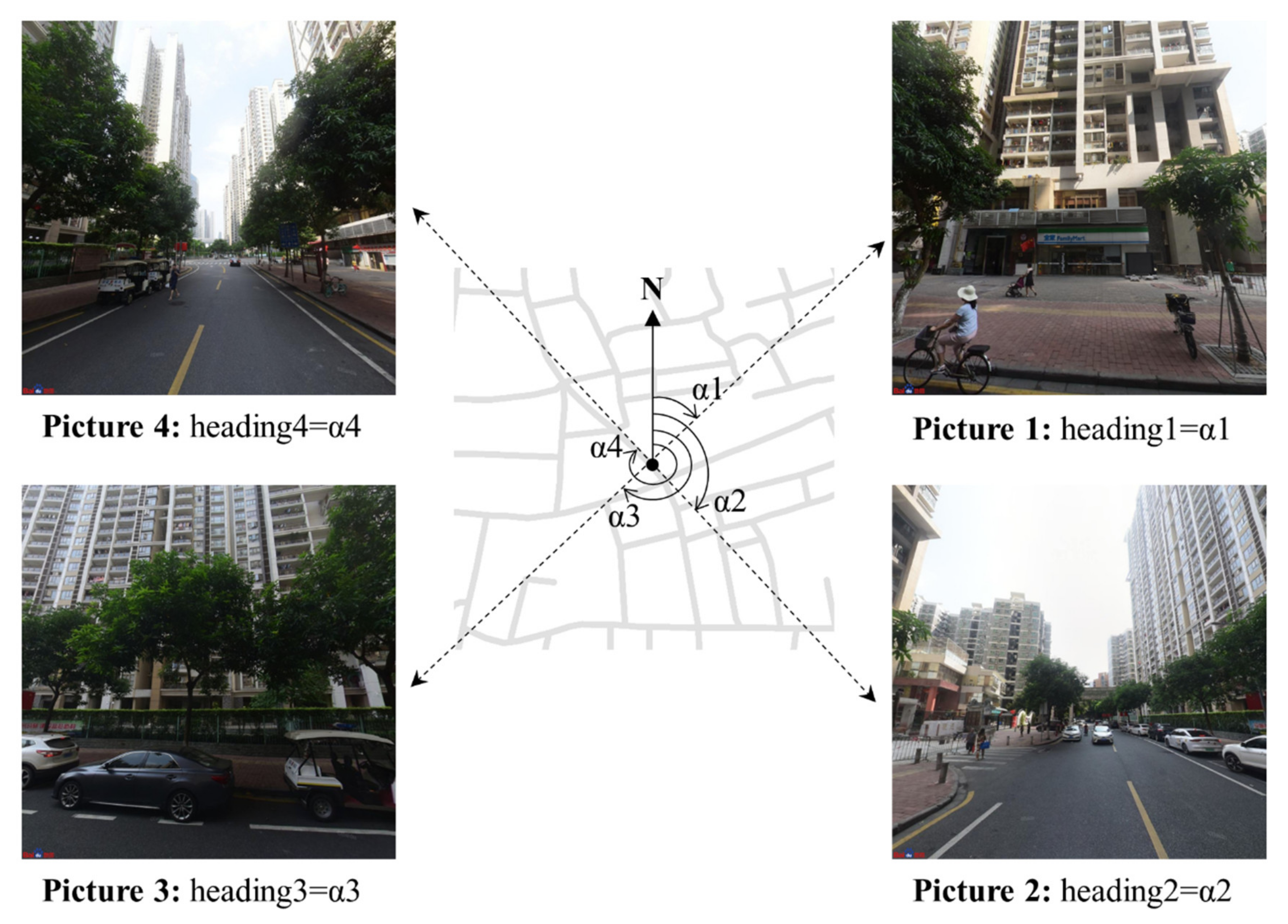
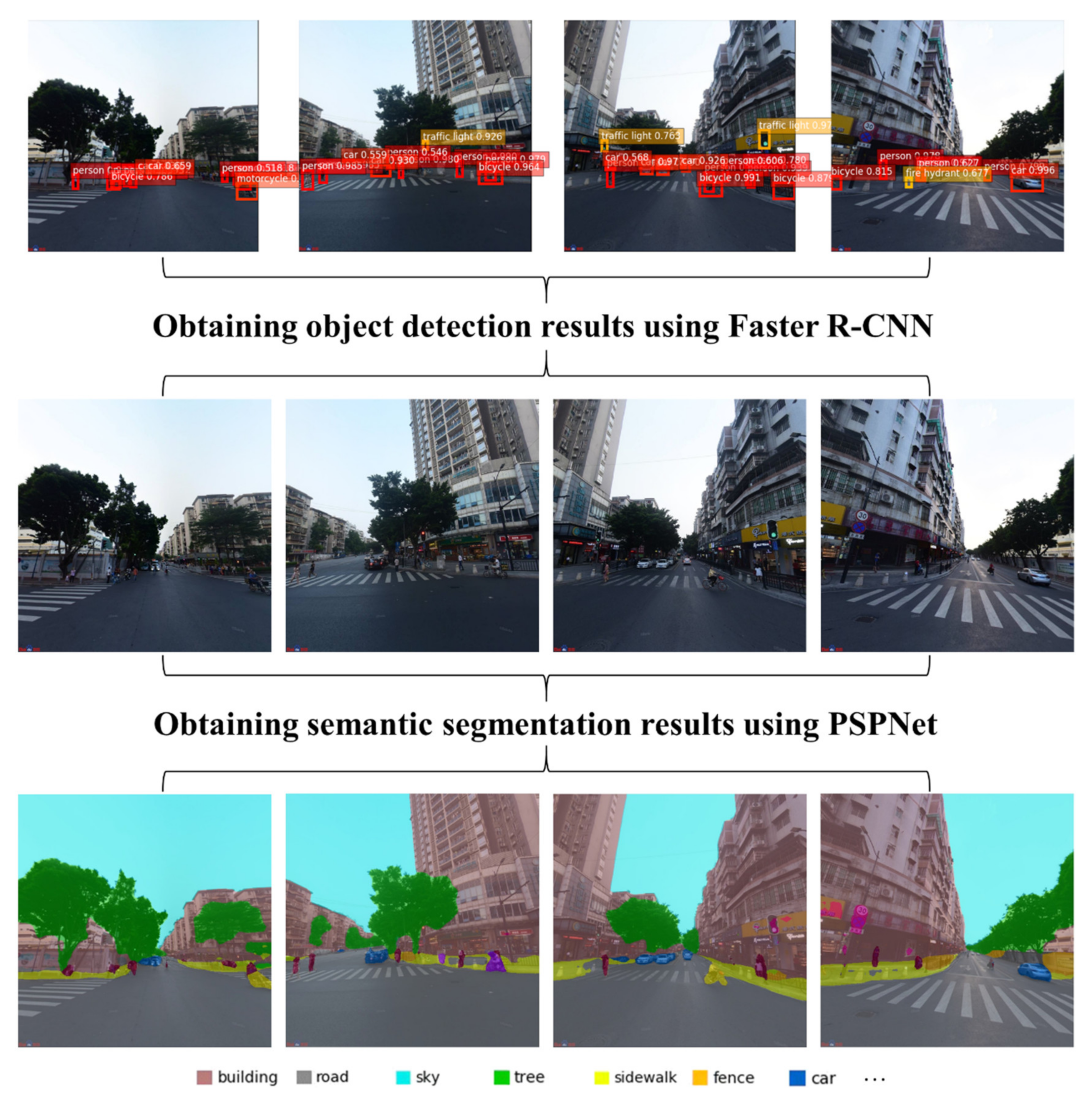
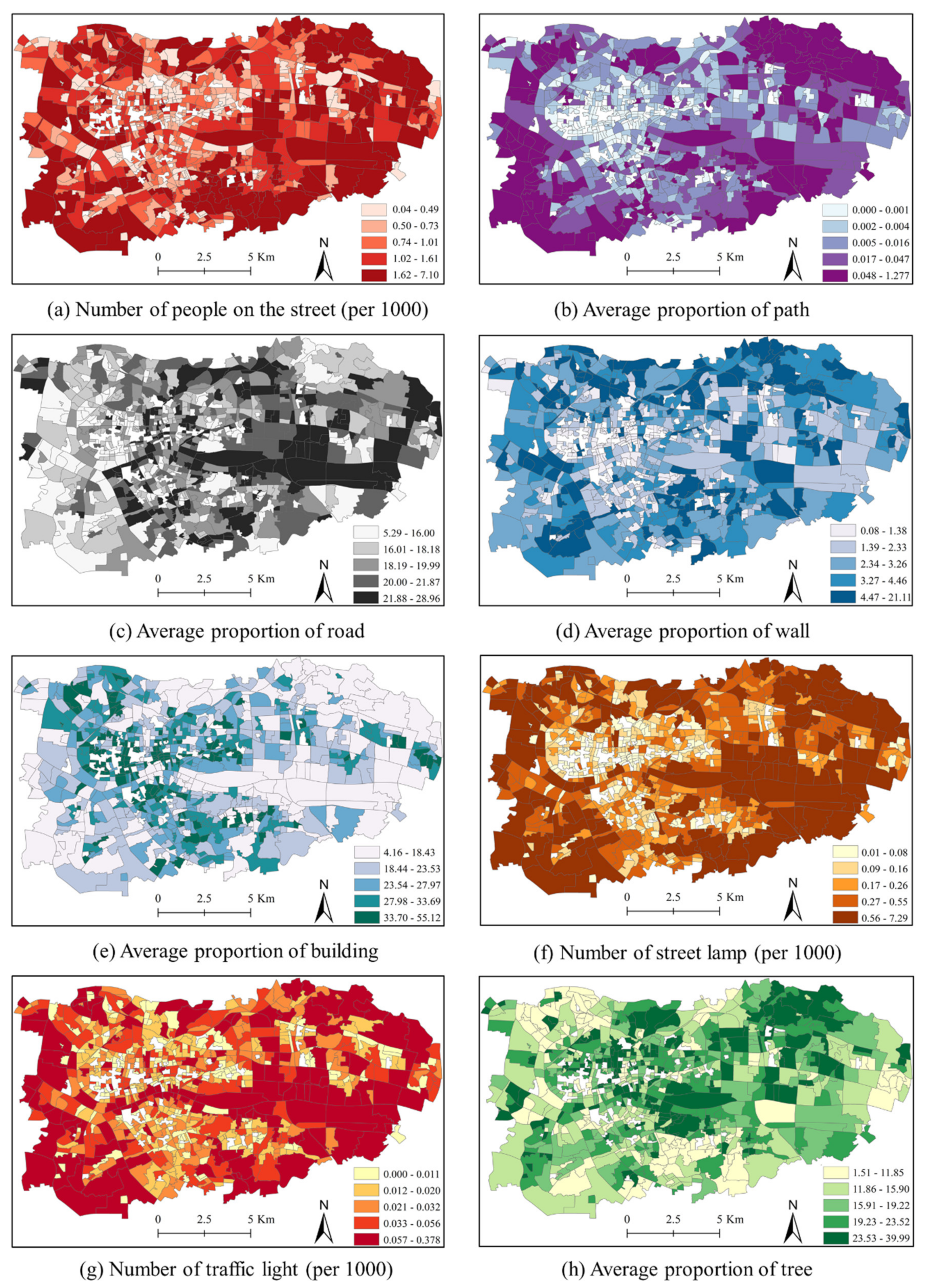
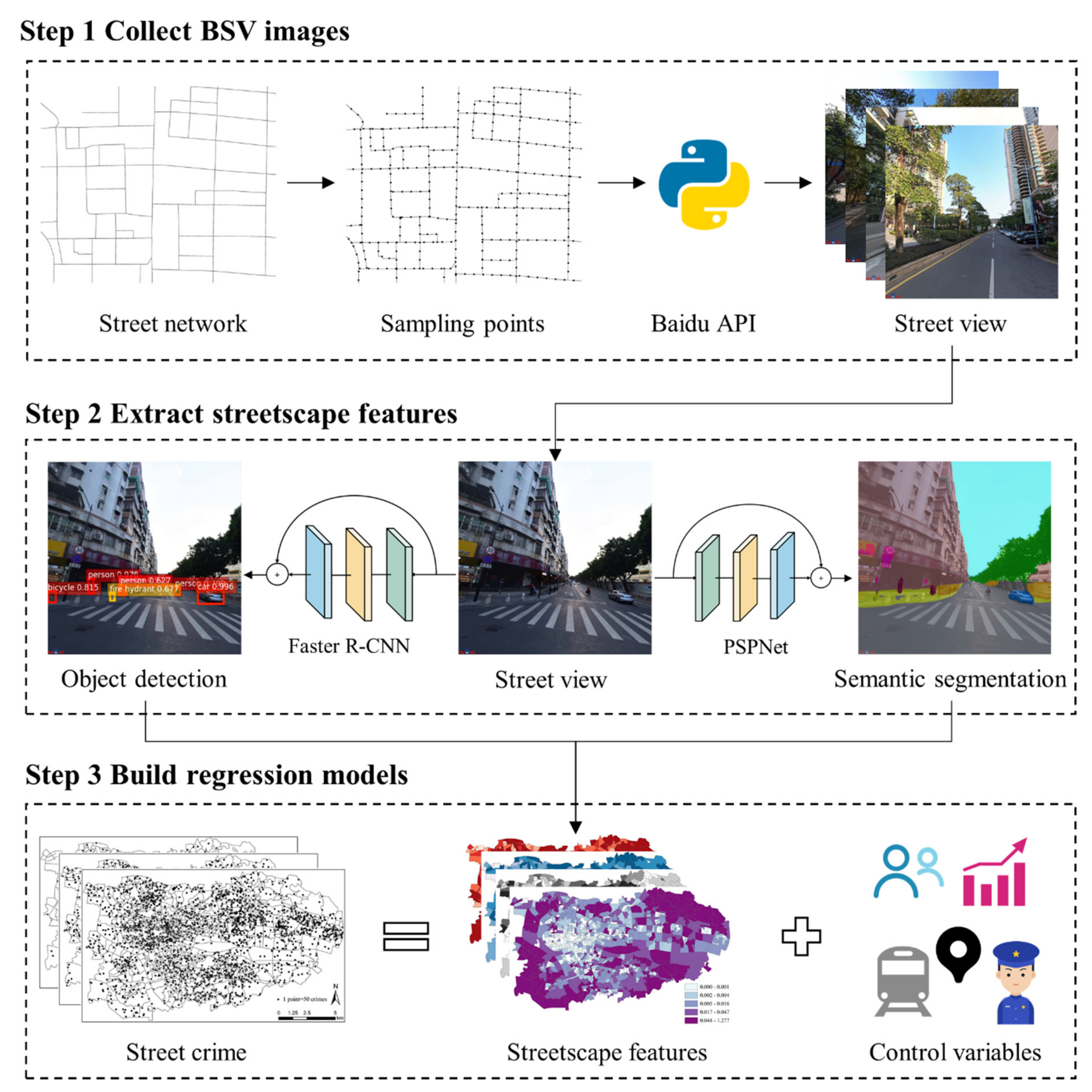
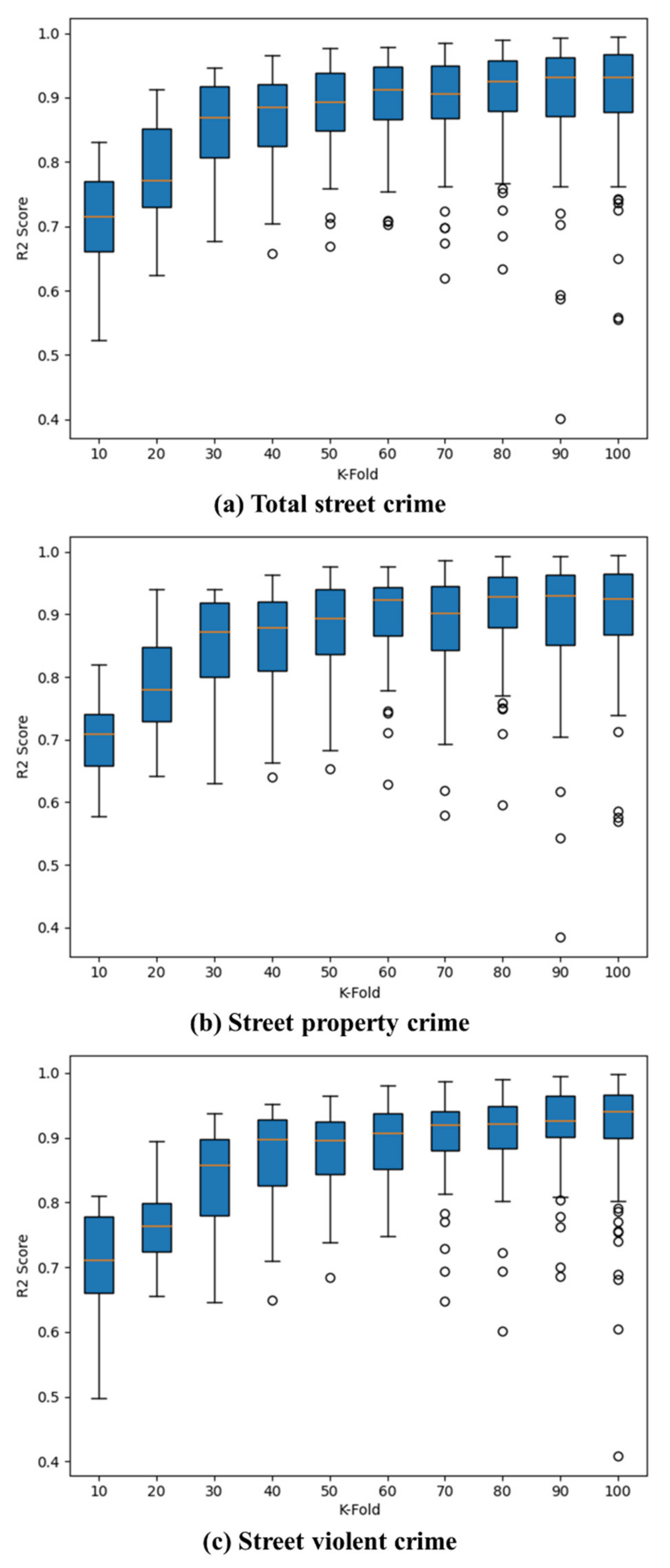
| Variable | Mean | SD | Min | Max |
|---|---|---|---|---|
| Dependent Variables | ||||
| Number of total street crimes | 155.28 | 183.79 | 5 | 1952 |
| Number of street property crimes | 126.53 | 155.67 | 3 | 1808 |
| Number of street violent crimes | 28.75 | 34.40 | 0 | 306 |
| Control Variables | ||||
| Rate of young people (%) | 26.534 | 5.908 | 4.654 | 47.431 |
| Rate of highly educated people (%) | 14.316 | 12.565 | 0.000 | 86.245 |
| Rate of migrant people (%) | 42.235 | 21.494 | 0.203 | 98.518 |
| Rate of renters (%) | 30.636 | 23.441 | 0.000 | 100.000 |
| Number of POI (per 1000) | 0.323 | 0.283 | 0.004 | 2.451 |
| Mixture of POI | 0.826 | 0.074 | 0.341 | 0.904 |
| Number of bus stops | 1.769 | 2.121 | 0 | 15 |
| Number of subway stations | 0.111 | 0.351 | 0 | 3 |
| Number of police stations | 1.384 | 1.524 | 0 | 10 |
| Streetscape Variables | ||||
| Number of people on the street (per 1000) | 1.176 | 1.048 | 0.043 | 7.097 |
| Average proportion of paths (%) | 0.037 | 0.086 | 0.000 | 1.276 |
| Average proportion of roads (%) | 18.939 | 3.478 | 5.299 | 28.953 |
| Average proportion of walls (%) | 3.131 | 2.296 | 0.085 | 21.107 |
| Average proportion of buildings (%) | 26.218 | 8.753 | 4.166 | 55.116 |
| Number of streetlamps (per 1000) | 0.430 | 0.711 | 0.014 | 7.280 |
| Number of traffic lights (per 1000) | 0.038 | 0.042 | 0 | 0.377 |
| Average proportion of trees (%) | 17.611 | 6.705 | 1.519 | 39.980 |
| Dep. Var. | Total Street Crime | Street Property Crime | Street Violent Crime | |||
|---|---|---|---|---|---|---|
| Model | (1) IRR (Std. Err.) | (2) IRR (Std. Err.) | (3) IRR (Std. Err.) | (4) IRR (Std. Err.) | (5) IRR (Std. Err.) | (6) IRR (Std. Err.) |
| Control Variables | ||||||
| Rate of young people | 1.046 ** | 1.038 ** | 1.04 ** | 1.032 * | 1.08 *** | 1.073 *** |
| (0.019) | (0.019) | (0.02) | (0.019) | (0.02) | (0.020) | |
| Rate of highly educated people | 1.040 ** | 1.062 *** | 1.04 * | 1.059 *** | 1.06 *** | 1.069 *** |
| (0.019) | (0.021) | (0.02) | (0.021) | (0.02) | (0.021) | |
| Rate of migrant people | 1.032 | 1.024 | 1.03 | 1.019 | 1.04 * | 1.028 |
| (0.021) | (0.021) | (0.02) | (0.022) | (0.02) | (0.022) | |
| Rate of renters | 1.087 *** | 1.086 *** | 1.09 *** | 1.091 *** | 1.05 ** | 1.055 ** |
| (0.023) | (0.024) | (0.02) | (0.024) | (0.02) | (0.023) | |
| Number of POIs | 1.188 *** | 1.162 *** | 1.20 *** | 1.166 *** | 1.10 *** | 1.088 *** |
| (0.033) | (0.033) | (0.03) | (0.034) | (0.03) | (0.029) | |
| Mixture of POIs | 1.015 | 1.027 | 1.01 | 1.025 | 1.00 | 1.013 |
| (0.018) | (0.018) | (0.02) | (0.019) | (0.02) | (0.019) | |
| Number of subway stations | 1.005 | 1.000 | 1.01 | 1.005 | 0.97 | 0.963 ** |
| (0.018) | (0.018) | (0.02) | (0.018) | (0.02) | (0.017) | |
| Number of bus stops | 1.034 * | 1.004 | 1.03 * | 1.005 | 1.04 ** | 1.014 |
| (0.020) | (0.023) | (0.02) | (0.024) | (0.02) | (0.024) | |
| Number of police stations | 0.984 | 0.987 | 0.99 | 0.989 | 0.97 | 0.979 |
| (0.016) | (0.016) | (0.02) | (0.017) | (0.02) | (0.017) | |
| Streetscape Variables | ||||||
| Number of people on the street | 1.078 *** | 1.079 *** | 1.042 | |||
| (0.029) | (0.030) | (0.028) | ||||
| The average proportion of paths | 0.955 ** | 0.957 ** | 0.960 * | |||
| (0.019) | (0.020) | (0.021) | ||||
| The average proportion of roads | 1.019 | 1.015 | 1.037 | |||
| (0.024) | (0.025) | (0.026) | ||||
| The average proportion of walls | 0.979 | 0.975 | 0.997 | |||
| (0.021) | (0.021) | (0.022) | ||||
| The average proportion of buildings | 0.950 * | 0.951 * | 0.939 ** | |||
| (0.028) | (0.029) | (0.029) | ||||
| Number of streetlamps | 0.962 | 0.957 | 0.982 | |||
| (0.028) | (0.029) | (0.029) | ||||
| Number of traffic lights | 1.042 | 1.047 | 1.019 | |||
| (0.029) | (0.030) | (0.029) | ||||
| The average proportion of trees | 0.935 *** | 0.935 ** | 0.928 *** | |||
| (0.024) | (0.024) | (0.025) | ||||
| Spatial lag of dependent variable | 1.918 *** | 1.851 *** | 1.946 *** | 1.882 *** | 1.997 *** | 1.939 *** |
| (0.064) | (0.061) | (0.068) | (0.065) | (0.056) | (0.054) | |
| Log-likelihood | −3837.600 | −3821.261 | −3704.309 | −3689.161 | −2608.377 | −2592.888 |
| AIC | 7699.199 | 7682.521 | 7432.617 | 7418.322 | 5240.753 | 5225.775 |
Publisher’s Note: MDPI stays neutral with regard to jurisdictional claims in published maps and institutional affiliations. |
© 2022 by the authors. Licensee MDPI, Basel, Switzerland. This article is an open access article distributed under the terms and conditions of the Creative Commons Attribution (CC BY) license (https://creativecommons.org/licenses/by/4.0/).
Share and Cite
Yue, H.; Xie, H.; Liu, L.; Chen, J. Detecting People on the Street and the Streetscape Physical Environment from Baidu Street View Images and Their Effects on Community-Level Street Crime in a Chinese City. ISPRS Int. J. Geo-Inf. 2022, 11, 151. https://doi.org/10.3390/ijgi11030151
Yue H, Xie H, Liu L, Chen J. Detecting People on the Street and the Streetscape Physical Environment from Baidu Street View Images and Their Effects on Community-Level Street Crime in a Chinese City. ISPRS International Journal of Geo-Information. 2022; 11(3):151. https://doi.org/10.3390/ijgi11030151
Chicago/Turabian StyleYue, Han, Huafang Xie, Lin Liu, and Jianguo Chen. 2022. "Detecting People on the Street and the Streetscape Physical Environment from Baidu Street View Images and Their Effects on Community-Level Street Crime in a Chinese City" ISPRS International Journal of Geo-Information 11, no. 3: 151. https://doi.org/10.3390/ijgi11030151
APA StyleYue, H., Xie, H., Liu, L., & Chen, J. (2022). Detecting People on the Street and the Streetscape Physical Environment from Baidu Street View Images and Their Effects on Community-Level Street Crime in a Chinese City. ISPRS International Journal of Geo-Information, 11(3), 151. https://doi.org/10.3390/ijgi11030151







